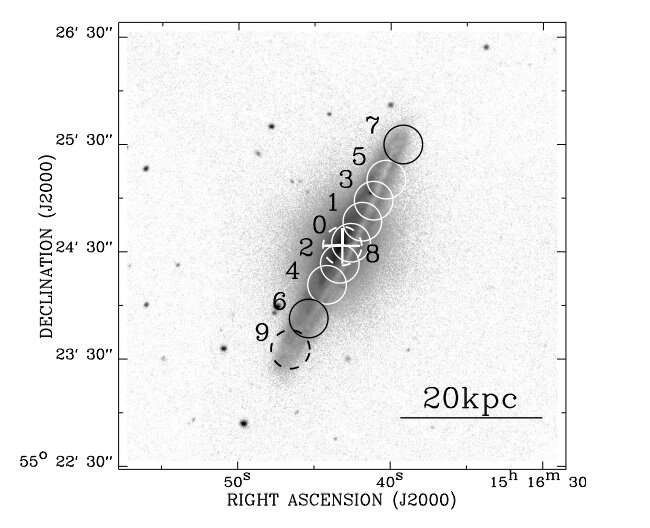April 18, 2019 report
Research provides insights into molecular gas in the massive spiral galaxy NGC 5908

In a recently published research, which is part of a broader observational campaign focused on studying massive spiral galaxies, astronomers have investigated molecular lines of carbon monoxide and its isotopologues in NGC 5908. The study, detailed in a paper published April 10 on arXiv.org, sheds more light on properties of molecular gas in this galaxy, what could be helpful to better understand the evolution of such massive objects.
Massive spiral galaxies, with stellar masses few times greater than that of the Milky Way, often have relatively low star formation rates (SFRs), even lower than that of our home galaxy. This baffles astronomers, as it is impossible for these galaxies to build up such huge stellar mass with just continuous star formation at this SFR. Hence, some other mechanisms that influence galactic evolution are likely taking place in massive spiral galaxies.
In order to gain more insights on this topic, further research on overall content and spatial distribution of molecular gas in galaxies of this type are required. Such studies could disclose how molecular gas builds up the stellar content of these massive objects.
With that aim in mind, a team of astronomers led by Jiang-Tao Li of University of Michigan, used the IRAM 30m millimeter radio telescope, located in Spain, to conduct observations of molecular lines of carbon monoxide and its isotopologues from NGC 5908. The target of the observational campaign, carried out under the Circum-Galactic Medium of MASsive Spirals (CGM-MASS) project, is a highly inclined massive spiral galaxy about 170 million light years away from the Earth, with a stellar mass of around 256 billion solar masses and SFR of approximately 3.81 solar masses per year.
"In this paper, we focus on the initial results from the IRAM 30m observations of NGC 5908, which has the highest-quality data and is the nearest galaxy in the CGM-MASS sample," the astronomers wrote in the paper.
The study found that the total mass of molecular gas in NGC 5908 is about 8.3 billion solar masses, while with the addition of atomic hydrogen, the total cool gas mass is at a level of 13 billion solar masses, which makes it one of the most massive isolated spiral galaxies. However, although these results confirm that the cool gas in NGC 5908 makes a significant contribution to the galaxy's gas budget, it is still far from sufficient to account for the galaxy's expected total baryon mass of around 2 trillion solar masses.
The observations also revealed that NGC 5908 has a dark matter halo with the mass of approximately 10 trillion solar masses. This, together with other results, indicates that NGC 5908 is one of the most massive spiral galaxies yet known in the local universe, and suggest that it evolved largely in isolation.
Furthermore, the researchers found that one of the studied molecular lines and the estimated gas temperature indicate a relatively weak star formation in NGC 5908. The results also suggest that radiative cooling of the hot circum-galactic medium (CGM) or any other external gas supplies are probably insufficient to compensate the gas consumed in star formation.
Therefore, analyzing all the results of IRAS observations, the researchers concluded that NGC 5908 is probably now at an early stage after the starburst, with plenty of leftover cool gas. "Since there is no signature of recent triggering of star formation (such as galaxy merger, gas transfer, or enhanced cooling of the CGM etc.), we conclude that NGC 5908 is not completely quiescent, and it may be in the early stage after the previous starburst, before the star formation is completely extinguished and the ejected gas cools and falls back to the galaxy," the astronomers wrote.
More information:
Jiang-Tao Li et al. Molecular Gas of the Most Massive Spiral Galaxies I: a Case Study of NGC 5908. arXiv:1904.05413 [astro-ph.GA].
arxiv.org/abs/1904.05413
© 2019 Science X Network





















